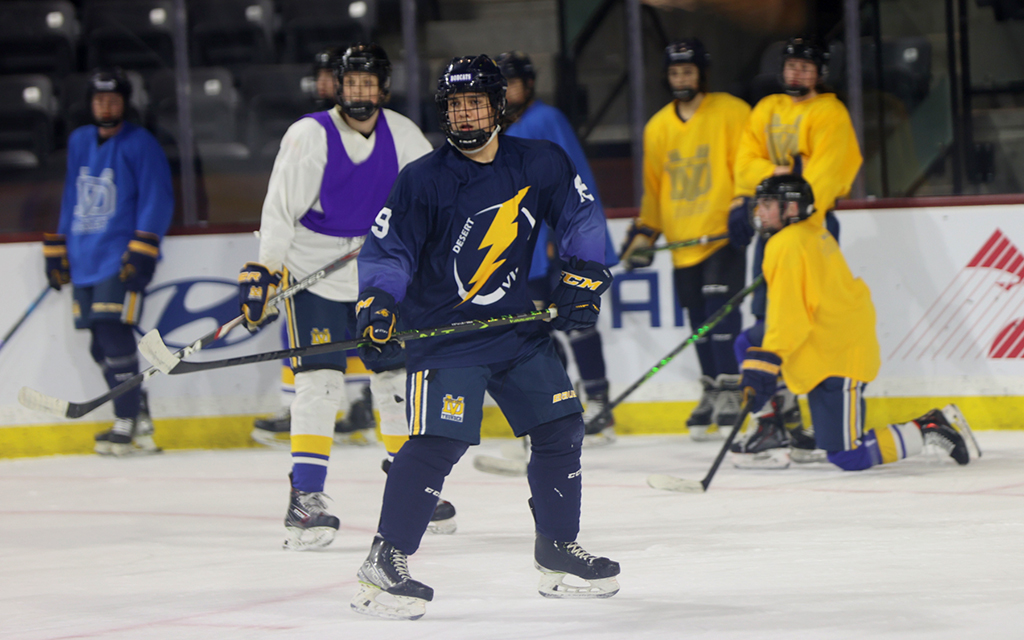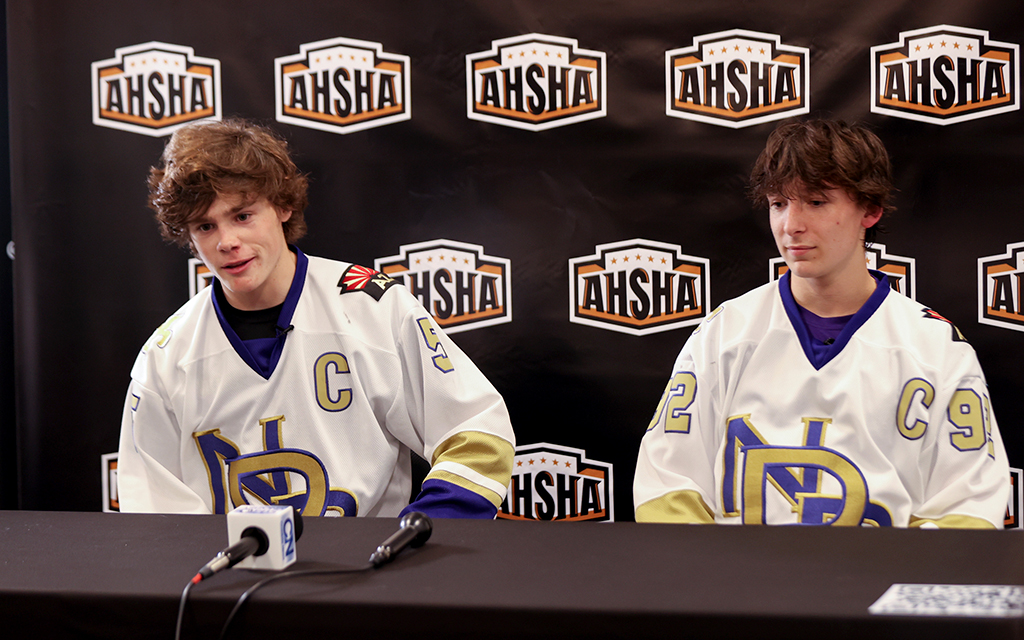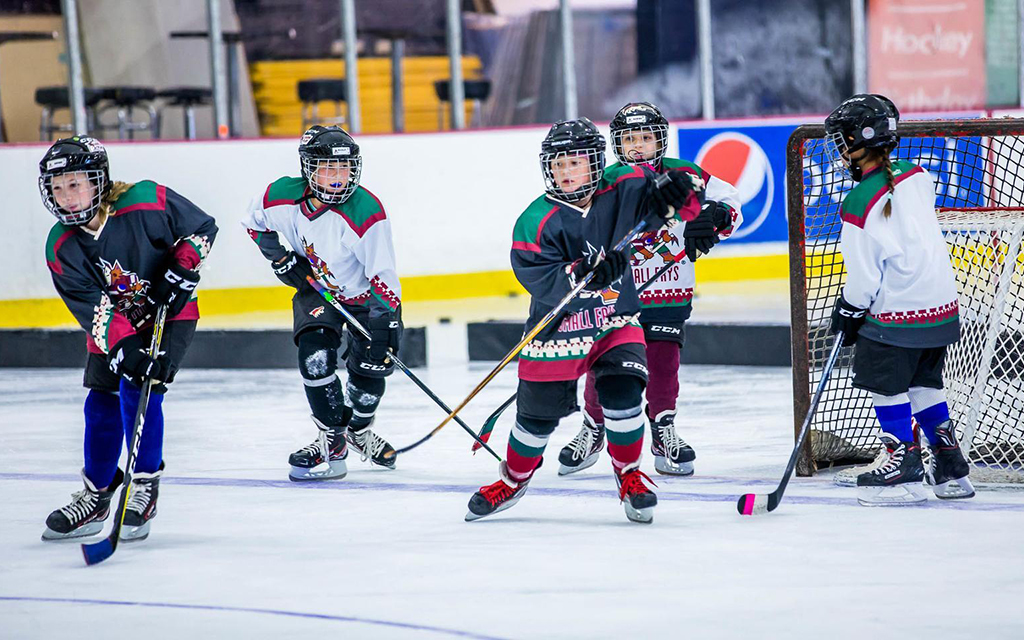TEMPE – Dry heat, rocky terrain and no ice. Hockey in the desert has long been described as a sport that wouldn’t thrive, especially for high school athletes.
However, hockey in Arizona has done the opposite in the last 10 years. It’s been booming. Since the 2012-13 report by USA Hockey on amateur participants in each state, there has been an increase of 5,107 in youth hockey players in Arizona from the ages of 6-19.
With many indoor hockey rinks spread across the state, the youth hockey world has expanded exponentially. However, the Arizona Interscholastic Association doesn’t sanction the sport for high school, and for decades that left students with two options – not playing organized hockey at all or having to pay to play on a club team.
Creation of the AHSHA
The Arizona High School Hockey Association was founded in 1999 to give youth hockey players the opportunity to participate in high-level competition with different schools across the state.
The sport hasn’t been sanctioned by the AIA, as no group, school or board member has ever brought the idea to the attention of the Executive Board. While the sport is consistently expanding yearly, the AIA has never expressed interest in the sport becoming sanctioned according to Jenna Mazel, Marketing Coordinator for the AHSHA.
Currently, the AHSHA has four divisions with each featuring at least six teams, with 40 total spread throughout Arizona. The teams play in traditional matchups every Thursday and Saturday, with a play-in semifinal at the end of January followed by the championship in early February. This year’s title bout is Saturday when Desert Vista High School and Notre Dame Preparatory School drop the puck at Mullett Arena.
Participation in the AHSHA is at the school’s discretion. Athletes generally are placed on a team dependent on their skill level. Some teams, however, are “pure teams,” meaning that every kid on that team goes to that school.
However, some teams are hybrids of athletes from different schools, including a school that may not have a program. Last year’s winner, Pinnacle High School, went on to play at USA Hockey National Championships in Dallas, while an all-star team was brought to the America Showcase.
In 2022, that all-star team placed third, the highest out of any team to ever come from Arizona.
“We’re trying to be a good leader for hockey in the desert,” Mazel said. “We want kids that play house hockey, that are younger to look at AHSHA and be like, ‘I wanna play that. That looks like a cool league.’ Whereas in the past, I think maybe like 10-15 years ago, AHSHA was looked at as a goon league. Like kids would much rather play travel hockey, like mission host leagues.”

Daniel O’Reilly (89) believes that if AHSHA didn’t exist, he wouldn’t nearly have the same opportunities, including a potential USA Nationals run. (Photo by Grace Edwards/Cronkite News)
High school hockey shouldn’t be sanctioned
Andrew Sharr, a former Mesquite High School hockey player, believes there is no reason for the AIA to sanction the sport at the moment because the Arizona High School Hockey Association is independently operated successfully.
“From my previous experience, it seems like they run the league just fine,” Sharr said. “The game day structure, you just play your games on weekends. They do have an all-star team. The way the championship leagues are run, you know, they run the league very well for what they have.
“They do a great job, they make sure that the people are taken care of. They run like a strict league. They really do. So I don’t think that they necessarily need to be sanctioned in that sense because they haven’t exactly had any issues.”
The AHSHA has been operating independently of the AIA since its inception, and Mazel says that with the success the league has had in the last year alone, they have never wanted to become an AIA-sanctioned sport.
“(For a) sport to get sanctioned by AIA, somebody has to bring it in front of their board and they vote on it and it’s never been voted on,” Mazel said. “And I think everything that we do, like our operations run smoothly. So there’s never been a reason (for us) to do that.”
With equipment and ice space being costly, athletes and their families pay to participate in the high school league, and this further enhances the AIA’s reasoning to not sanction the sport, according to Seth Polansky, Director of Sports Information at the Arizona Interscholastic Association.
While most AIA-sanctioned sports like badminton have to adhere to a strict set of rules, pay a set amount in fees, and have a group of schools that participate in Division I and Division II, the AHSHA operates on rules set by the people who love the sport most: hockey enthusiasts.
“The jerseys and all of those were provided to us, like our helmets and our gloves, but as far as your skate blades or your chest pads or your actual skates, none of those were provided, but the actual helmets, because we had blue helmets, those were provided, but everything else you kind of had to fend for yourself,” Sharr said.
Why not club hockey?
Most people who play hockey in Arizona either play for a house or club team, but with the opportunities the AHSHA creates, more players throughout the state are making the switch over to high school leagues rather than playing club.
“I don’t think it’s an issue that most people know about, to be honest with you. I think that people kind of tend to overlook the sport here in Arizona,” Sharr said. “So I think people are more focused on the other sports – football, basketball and baseball. So I don’t think that hockey has even been given the ability to get recognized in that sense, where it’s like being brought up to the board to be a sanctioned sport or anything like that.”
For Desert Vista senior Kelton Chadwick, playing high school hockey has brought him an entirely new wave of friends and opportunities that he never would have had playing club.
“It’s gotten me the team. It’s so much it’s so much fun, travel (hockey) can get a little too competitive, a little too argumentative,” Chadwick said. “High school is all fun. We’ve just had such a great experience.”
Desert Vista senior Daniel O’Reilly echoed Chadwick’s sentiment, saying he believes that if AHSHA didn’t exist, he wouldn’t nearly have as many opportunities as he has had, which includes the possibility of a USA Nationals run.
“It’s a great way to bond with people that you wouldn’t normally bond with at school, like you make friends all over the place and you can really spread just friendship around the school and build a community. It’s pretty awesome,” O’Reilly said.
With annual participation in Arizona high school hockey increasing yearly, the sport’s high cost is a factor but for some, the community that high school hockey brings and the “wanting to have fun” nature makes it worthwhile.
“I coached both travel and the high school level and they’re both great for me. However, in high school, you get someone for four years to get a young man or woman from their freshman (through) their senior (year and) you watch them develop. That’s the beauty of being a coach, you know, you bring a child in and they graduate as adults, young adults,” Notre Dame Prep head coach Charles Miscio said. “It’s so much more than just hockey. It’s (AHSHA) creating great citizenship and creating community, which is extremely important.”

Notre Dame Prep co-captain Evan Kobley, right, says it’s “iconic” to be able to play in front of roughly 4,000 fans at Mullett Arena on Saturday in the AHSHA State Championship. (Photo by Grace Edwards/Cronkite News)
The league has expanded and word is spreading
Hockey in the desert has long been described as a curious fit. From youth to college hockey, those who have come to play hockey in Arizona have always been asked the burning question of “why?”
The answer? Most of the time, it’s the program the athlete is coming to play for. Although the Valley is not known for its mountains of snow in the winter or a rainy spring, hockey players now more than ever are playing the game in the desert.
However, homegrown hockey players have blown the sport up in Arizona. The AHSHA currently has a wait list for those to join their program, but if you would’ve asked how many players participated 10 years ago, the answer would’ve been less than 500.
In 2015, 538 players participated in AHSHA play, and this year, registration sold out within an hour, for all levels – Division I, Division II, Division III and JV – while influences like ASU hockey and the Arizona Coyotes have helped guide the sport’s substantial growth.
In 1996, there were only three rinks, two in Phoenix and one in Flagstaff. NAU had a strong Div. I hockey team in the 1980s, with the Lumberjacks recruiting high-caliber athletes (some of whom ended up playing in the NHL) and playing elite teams from all over North America, but the program was canceled when the ice facilities in Walkup Skydome needed expensive repairs.
Currently, there are 14 host arenas spread throughout the state with the majority being in the greater Phoenix metropolitan area, with one arena in both Flagstaff and Tucson. While local fans know when games take place, the general public doesn’t and with that comes an entirely new fandom to be discovered.
“Everybody knows that this arena was just built. It’s for (the) Coyotes and ASU and having a high school game here would be really good news for (the league),” Desert Vista senior goaltender Tagger Tamburo said of Mullett Arena, the intimate facility in Tempe where Saturday’s AHSHA title game takes place.
Desert Vista High School and Notre Dame Preparatory School face off in the championship, and the possibility of selling out tickets is imminent, with parents, players and students eager to get a look into the future of hockey in the desert.
“You have the Coyotes, you have ASU, it’s definitely bringing awareness to it, like, having Mullett Arena to have our championship game out at is awesome,” Mazel said. “We’re so excited and I think the kids are so excited and like that’s bringing it to a focal point. In the past, we’ve had it at Oceanside (Ice Arena). And every year it’s sold out.”
AHSHA expects around 3,500 to 4,000 fans will attend Saturday’s bout, the highest attendance in the league’s history, with last year’s championship only having 750 fans due to Oceanside Ice Arena’s restrictions.
“There’s a lot of words to describe it (the state championship), but the one that’s coming to mind right now is iconic. I mean, you grow up and you see those in the NHL lifting the Stanley Cup, you see people winning state championships, and that’s always kind of what you’re pushing for,” Notre Dame Prep senior captain Evan Kobley said. “You always want to win and be the best, and that’s always kind of a goal for teams. And there’s nothing that sums it up better than seeing your buddies and lifting up that trophy above your head. So it’s a pretty special moment.”
In 24 years the league has proved that it is capable of making hockey in the desert the next big thing. Although basketball, baseball and football are still most of Arizona’s go-to sports, AHSHA’s reach has given students the opportunity to play hockey without the high cost of club teams.
“I think ASHA has done an incredible job. Just promoting, and I think what we’re seeing right now is, a lot of players that play at the travel level, are really feeling, ‘sowing their oats’, so to speak, that, you know, hockey players grow up, no one knows when your kid’s this big, what they do, you don’t play football, you don’t play basketball. It’s a sport that, you know, very select people play,” Miscio said.
“I think it’s just going to continue to grow. The amount of people that were at our games showing school pride is a big deal. So it’s the first time in a long time that hockey players have been able to walk around with school pride.”



